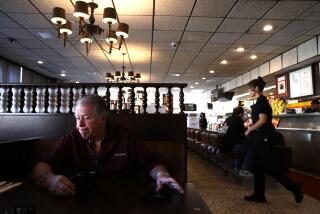Urban Scene : Chinatown: A Rich Resource for L.A. : Redevelopment: Planners are studying ways to revitalize Central City North. Renewal of this urban backwater would enhance its status as a cultural asset.
Standing in the middle of Chinatown, surrounded by signs in Mandarin and lured by the aroma of mouth-watering dim sum exuding from restaurant doorways, you might forget for a moment that you are in Los Angeles, within a stone’s throw of City Hall.
Called Central City North by planners, the area north of downtown Los Angeles that includes Chinatown is both the oldest part of the city and its least defined.
Obscured by the long shadows of Bunker Hill’s skyscrapers, Central City North has been an urban backwater for decades. But it is richer in human and architectural resources available for future development than any other section of the city.
To probe its many possibilities for renewal, the area was the subject of a recent five-day study blitz, or charette , conducted by a 15-member Design Action Planning Team (DAPT) sponsored by the city Planning Department and the Urban Design Advisory Coalition.
The study is the fourth in a series that previously focused upon Van Nuys, Los Feliz and Watts.
Central City North is triangular in shape and is bounded by the Hollywood-Santa Ana, Pasadena and Golden State freeways. Bisected by a stretch of the neglected Los Angeles River, the district embraces not only Chinatown but also the original Pueblo de Los Angeles, Union Station, a section of Elysian Park, shabby industrial and residential districts and a confusion of under-used rail yards.
Fundamental forces are now at work to change Central City North, the planners found.
“If (these changes are) properly planned for and managed, (they) could be harnessed to create new opportunities to unify the area and enhance it as a multifaceted cultural and historical asset for the entire city,” the DAPT report said.
Those forces include the planned development of the land around Union Station and the market demand for new office space close to downtown. The challenge faced by the planning team was to integrate these development pressures with the creation of a coherent community and reduce its freeway-bound isolation from the rest of the city.
“The key words for Central City North’s future must be consolidation and connection ,” said USC architecture dean Robert Harris, DAPT co-leader.
“In our recommendations, we emphasized the strengthening of the identity and coherence of existing neighborhoods within the study area and the development of strong links between them and the surrounding communities,” Harris said.
The other DAPT co-leader was Charles Zucker, director of community assistance initiatives of the American Institute of Architects. Members of the team include Munson Kwok, chairman of the Chinatown Community Advisory Committee; architect Franklin Po; Helene Ly, community planner with the city of Los Angeles, and economist David K. Hyun.
In Chinatown, the heart of Central City North, the DAPT recommends that principal thoroughfares such as Hill Street, Broadway and Spring Street be developed as densely urban, street-oriented commercial and residential avenues to accommodate the immigrants from Hong Kong, Vietnam and Taiwan who settle there on arrival in Los Angeles.
To consolidate the district’s identity, a series of gateways would be created to mark entry into Chinatown, which would be connected with Olvera Street and Union Station by reinforced crossover points that would encourage pedestrian exploration.
All these sections would share proximity to a newly created green space running from Elysian Park to Union Station alongside landscaped borders of the Los Angles River.
In this area, named the River Park District, schools, community centers and affordable housing developments would be laced with waterside walks close to the factories and workshops that employ the area’s mainly unskilled or semi-skilled inhabitants.
The DAPT report suggests that the River Park District could house 15,000 new residents and create 20,000 new jobs. Much of the park district would take over the rail yards and transform this bleak area into a vibrant and largely self-supporting community.
Another strong spine connecting the sections of Central City North with one another and the outside world would run along a widened North Broadway-Alameda Street corridor from Lincoln Heights to Little Tokyo.
This corridor would be enhanced along part of its route by a section of the Pasadena-Los Angeles light-rail line planned to link downtown with the West San Gabriel Valley.
The proposed Chinatown light-rail station on Alameda Street would be connected to Union Station by an elevated pedestrian walkway that will “gracefully wind its way over College, Alpine and Macy streets.”
An “internal circulator” bus system that laces through Central City North would share interchanges with the DASH routes that run through downtown.
“If properly designed and operated,” the report declares, “the (bus system) can become one of the attractions for visitors” to the district.
In presenting the report to the residents of Central City North, the design team stressed its vision of “a future that knits together the diverse communities, integrates the Los Angeles River with the city, and cultivates an exciting, culturally rich and active environment.”
It deplored the “present perception which (tends to) consider each part as unrelated project areas which may or may not be planned together.”
The report states that when taken together with the Children’s Museum in City Hall East, Little Tokyo, the Music Center and the Museum of Contemporary Art, Central City North could be an integral element in a future in which “a new cultural heart for the city is envisioned.”
Architect Po, a DAPT participant with strong ties to the Chinatown community, said that the response to the report’s recommendations by local residents has been “warily enthusiastic.”
While naturally concerned that the proposals might threaten the complex social balance that exists in the area, most of the people who live there favor the kind of thoughtful, mixed-used growth outlined in the DAPT plan, Po said.
Meetings between the planners and the community to discuss the report in depth are scheduled in March.
More to Read
Sign up for Essential California
The most important California stories and recommendations in your inbox every morning.
You may occasionally receive promotional content from the Los Angeles Times.






